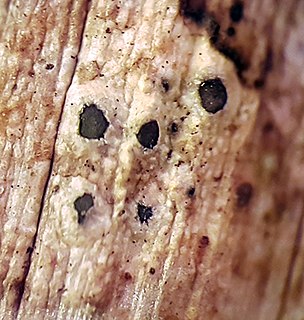
Lichenology is the branch of mycology that studies the lichens, symbiotic organisms made up of an intimate symbiotic association of a microscopic alga with a filamentous fungus.
Lithothelium is a genus of lichen-forming fungi in the family Pyrenulaceae. Most of the species are found in tropical climates, and are usually corticolous (bark-dwelling) or saxicolous (rock-dwelling). The genus was circumscribed by Swiss botanist Johannes Müller Argoviensis in 1885.
Sporopodium is a genus of lichen-forming fungi in the family Pilocarpaceae.

Mazosia is a genus of lichen-forming fungi in the family Roccellaceae. The genus was circumscribed by Italian lichenologist Abramo Bartolommeo Massalongo in 1854.

Anisomeridium is a genus of lichens in the family Monoblastiaceae. The type species was originally named Arthopyrenia xylogena by Swiss botanist Johannes Müller Argoviensis in 1883; in 1928, Maurice Choisy defined the genus Anisomeridium, designating A. xylogena the type species.
Ferraroa is a single-species genus in the family Gomphillaceae. It is a monotypic genus, containing the single species Ferraroa hyalina, a foliicolous (leaf-dwelling) lichen. This species was originally described by Robert Lücking in 1997 as Gyalideopsis hyalina. The type specimen was collected from leaves of Inga oerstediana in Costa Rica. Lücking, Emmanuël Sérusiaux, and Antonín Vězda transferred the taxon to the newly circumscribed genus Ferraroa in 2005 after molecular phylogenetic analysis showed it to belong to a unique lineage. The generic name Ferraroa honours Argentinian lichenologist Lidia Itatí Ferraro, "for her many contributions to lichenology in southern South America, and to our knowledge of Gomphillaceae".
André Aptroot is a Dutch mycologist and lichenologist.

Dalip Kumar Upreti is an Indian lichenologist. He served as Director and Chief Scientist at CSIR-National Botanical Research Institute, Lucknow during 1988 to 2017. Also he served as Head of Lichenology and herbarium division. Presently he is serving as CSIR-Emeritus Scientist in the same division.
Rolf Santesson (1916–2013) was a Swedish lichenologist and university lecturer. He was awarded the Acharius Medal in 1992 for his lifetime contributions to lichenology.
Dharani Dhar Awasthi was an Indian botanist, taxonomist, and lichenologist, often given the appellation "Father of Indian Lichenology".
Peter Wilfred James (1930–2014) was an English botanist and lichenologist. He was a pioneer in the study of lichens as environmental indicators, especially of atmospheric pollution.
Thomas Hawkes Nash III is an American lichenologist. His research is about the biology and ecology of lichens, and the effects of air pollution on plants and lichens. He is known as an authority on the family Parmeliaceae. During his long career at the Arizona State University, he helped develop the lichen herbarium into a world-class collection with over 100,000 specimens representing more than 5000 species. In 2010, the year of his retirement, he was awarded the Acharius Medal for lifetime achievements in lichenology, and the following year had a Festschrift published in his honor.
Antonín (Toni) Vězda was a Czech lichenologist. After completing a university education that was postponed by World War II, Vězda taught botany at the Czech University of Life Sciences. In 1958, he was dismissed from his university position as a result of the restrictions placed on academic freedoms by the communist regime in power. He eventually was hired as a lichen researcher by the Czechoslovak Academy of Sciences, who allowed him to work from his apartment, which served also as an office and herbarium.

Emmanuël Sérusiaux is a Belgian lichenologist. His career, spanning more than four decades, has combined both lichenology research and political aspects of nature conservation. He spent several periods working as a researcher at the National Fund for Scientific Research and the University of Liège, the latter in which he accepted a faculty position as professor and head of the Plant Taxonomy and Conservation Biology unit. Sérusiaux also served for three non-consecutive appointments as Deputy Chief of Staff in the Government of Wallonia. He retired from both his academic and political positions in 2019.
Eugeniella is a genus of mostly leaf-dwelling (foliicolous) lichens in the family Pilocarpaceae. It contains 13 species. The genus was circumscribed in 2008 by lichenologists Robert Lücking, Emmanuël Sérusiaux, and Klaus Kalb, with Eugeniella psychotriae assigned as the type species. This lichen was originally called Patellaria psychotriae by Johannes Müller Argoviensis in 1881. The seven species that were initially included in the genus had previously been placed in the genera Bacidia and Byssoloma. Several newly identified species from Australasia and Central and South America were later added. Most of the species grow on leaves, although four of the Australasian species grow on bark.
Serusiauxiella is a genus of leaf-dwelling lichens in the family Strigulaceae. It has three species, all of which are found in wet tropical forests in China. The genus was circumscribed in 2020 by Shu-Hua Jiang, Robert Lücking, and Jiang-Chu Wei, with Serusiauxiella filifera assigned as the type species. The genus name honours Belgian lichenologist Emmanuël Sérusiaux, "in recognition of his important contributions to lichenology, foliicolous lichens and the genus Strigula".
Mazosia lueckingii is a species of foliicolous (leaf-dwelling) lichen in the family Roccellaceae. Found in India, it was formally described as a new species in 2008 by Krishna Pal Singh and Athokpam Pinokiyo. The type specimen was collected by the first author in the Darjeeling district at an altitude of 1,200 m (3,900 ft), where it was found growing on dicotyledon leaves. The lichen has a verrucose (warty) thallus with brown, hairless verrucae, a black hypothallus, and ascospores that measure 34–45 by 4–7 μm with 4 or five septa. The specific epithet lueckingii honours German-born lichenologist Robert Lücking, who, according to the authors, "has made remarkable contributions to the taxonomy and ecology of foliicolous lichens".
Aderkomyces sikkimensis is a species of foliicolous (leaf-dwelling) crustose lichen in the family Gomphillaceae. Found in India, it was formally described as a new species in 2006 by Athokpam Pinokiyo, Krishna Pal Singh, and Robert Lücking. The type specimen was collected by the first author from a subtropical forest near Damthang (Sikkim). It has also been recorded from the Darjeeling district of West Bengal. The specific epithet refers to the region of the type locality.
Thelenella indica is a species of foliicolous (leaf-dwelling) lichen in the family Thelenellaceae. Found in India, it was formally described as a new species in 2006 by Athokpam Pinokiyo and Krishna Pal Singh. The type specimen was collected by the first author in a tropical forest along the Assam-Linzey road in the East Sikkim district; here it was found growing on the leaves of a small Schima wallichii tree. It appears to be endemic to the Sikkim region of India.
Phylloblastia is a genus of foliicolous (leaf-dwelling) lichens in the family Verrucariaceae. The genus was circumscribed in 1921 by Finnish lichenologist Edvard August Vainio, with Phylloblastia dolichospora assigned as the type species.




